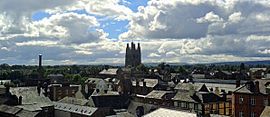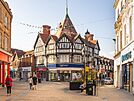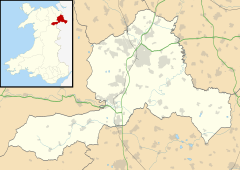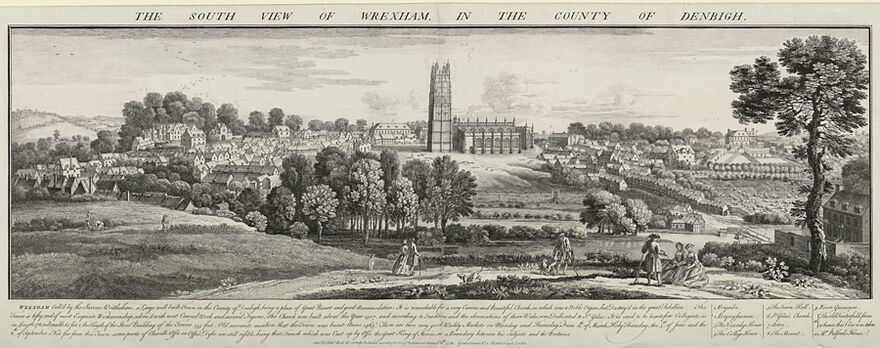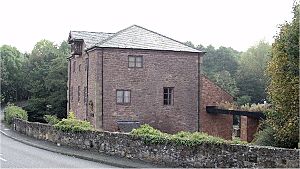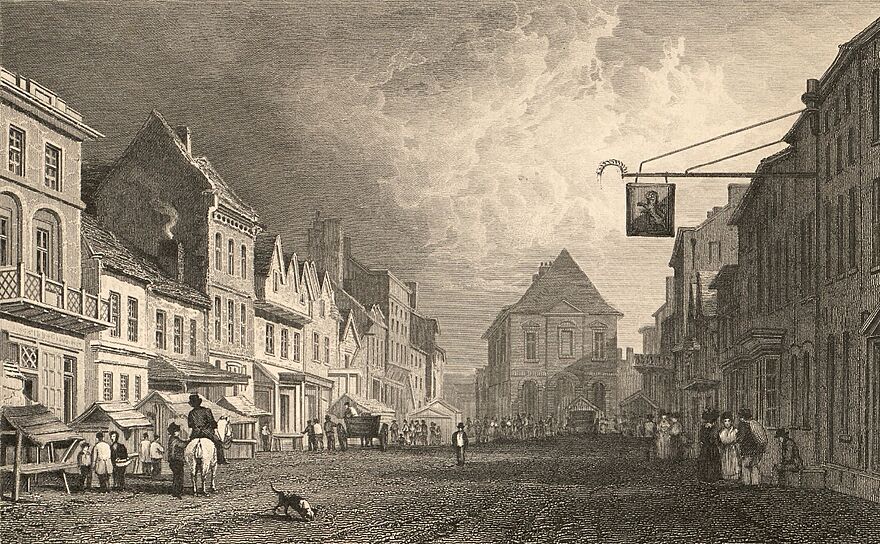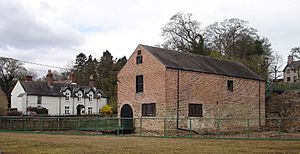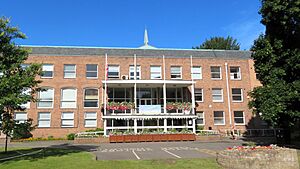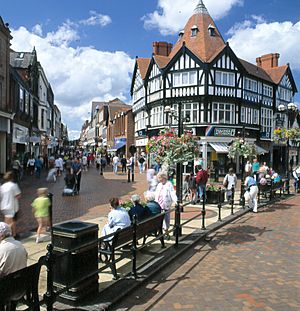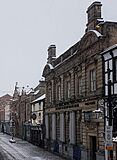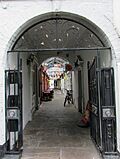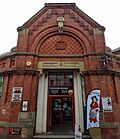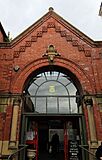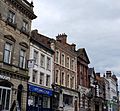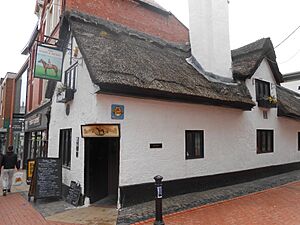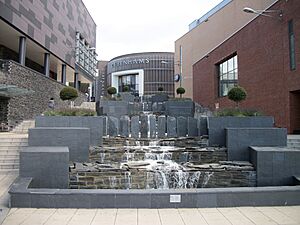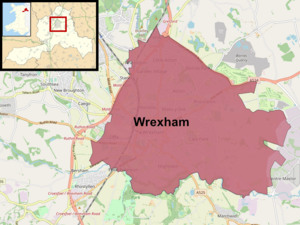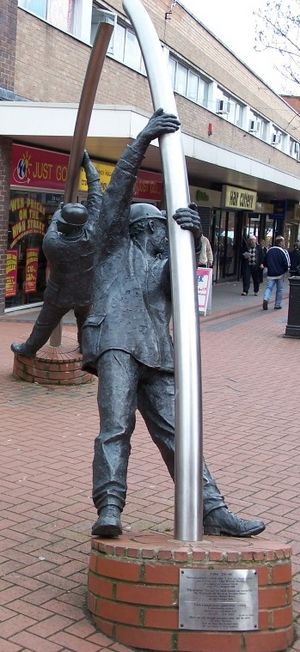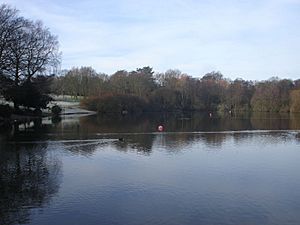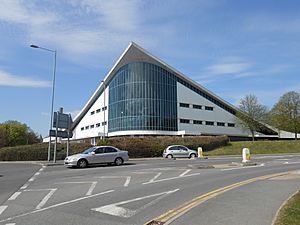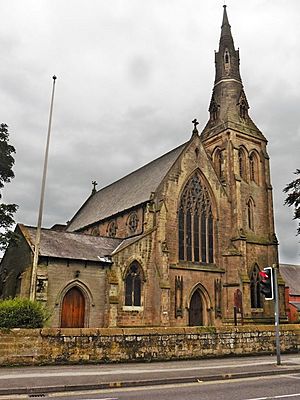Wrexham facts for kids
Quick facts for kids Wrexham
|
|
|---|---|
| City | |
|
From top, left to right: Wrexham skyline, Hope Street, Erddig Hall and St Giles' Church. |
|
| Population | 44,785 (Built up area, 2021) |
| OS grid reference | SJ335505 |
| • Cardiff | 108 mi (174 km) S |
| Principal area |
|
| Ceremonial county | |
| Country | Wales |
| Sovereign state | United Kingdom |
| Post town | WREXHAM |
| Postcode district | LL11—14 |
| Dialling code | 01978 |
| Police | North Wales |
| Fire | North Wales |
| Ambulance | Welsh |
| EU Parliament | Wales |
| UK Parliament |
|
| Welsh Assembly |
|
Wrexham (/ˈrɛksəm/ REK-səm; Welsh: Wrecsam [ˈrɛksam]) is a vibrant city located in the north-east of Wales. It sits between the Welsh mountains and the Dee Valley, very close to the border with Cheshire in England. Wrexham has been an important place for a long time. It was the largest settlement in Wales for a period in the 17th century.
Wrexham became a city in 2022. It is now the main town and administrative hub for Wrexham County Borough. In 2021, the city area had about 44,785 people. The wider county borough, which includes nearby villages, had a population of 135,117.
Wrexham was likely founded before the 11th century. It grew during the Middle Ages as a key place for trade and local government. During the Industrial Revolution, from the 18th century onwards, Wrexham was a major center for coal and lead mining. Other important industries included making iron, steel, leather, and brewing beer.
Today, Wrexham is a hub for manufacturing, shopping, education, and administration in north Wales. The city is famous for Wrexham A.F.C., one of the world's oldest professional football teams. It also has important industrial history along the Clywedog Trail, the beautiful National Trust property Erddig, and the impressive St Giles' Church in the city center.
Contents
History of Wrexham
Early Beginnings
People have lived in the Wrexham area since the Mesolithic period (8000 to 4300 BC). Tools made from flint have been found east of the city. There are two Bronze Age burial mounds west of the city center. This shows that the area was a center for metalworking a long time ago.
During the Roman conquest of Britain, a Celtic tribe called the Cornovii lived here. Romans also had a settlement in the Plas Coch area of Wrexham. They farmed and traded with other parts of the Roman world. After Roman rule ended, Wrexham became part of the Powys kingdom.
Medieval Times
The Battle of Chester around 615/616 started a long fight between the Welsh and English. In the 8th century, the Anglo-Saxon kingdom of Mercia expanded west. They built earth boundaries like Wat's Dyke and Offa's Dyke west of Wrexham.
Wrexham was likely founded during this time, on flat land near the River Gwenfro. The name Wrexham probably means "Wryhtel's river meadow" in Old English. By the 13th century, it was called 'Gwrexham' or 'Gregsam' in Welsh.
Welsh kings took back the Wrexham area in the 11th century. Wrexham became an important part of the Powys lordship of Maelor. The first mention of a castle at 'Wristlesham' was in 1161.
Wrexham grew as a trading and administrative town. In 1202, land in 'Wrechcessham' was given to Valle Crucis Abbey. The first church in Wrexham was mentioned in 1220.
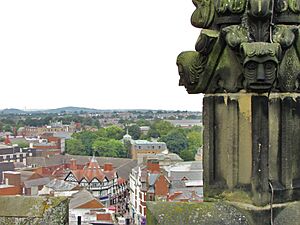
After Wales lost its independence in 1282, Wrexham became part of the Marcher lordship of Bromfield and Yale. It became a market town by 1327. Wrexham was known for making Welsh bucklers (small shields). In 1391, it was wealthy enough to support bards, jesters, and goldsmiths.
Local Welsh people supported Owain Glyndŵr's uprising against King Henry IV of England in the early 15th century. Poets like Guto'r Glyn praised Wrexham and its leaders.
Early Modern Period
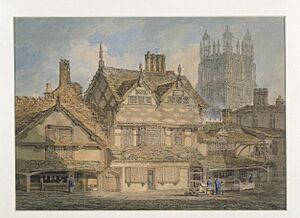
The Acts of Union in Henry VIII's time fully joined Wales with England. Wrexham became part of the new county of Denbighshire in 1536.
In 1584, St Richard Gwyn, a local teacher and poet, was executed for his Catholic beliefs. He was made a saint by Pope Paul VI in 1970. His Feast Day is October 17.
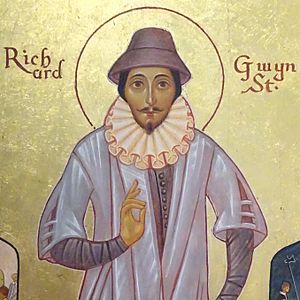
The main part of St Giles' Church was rebuilt in the late 15th and early 16th centuries. It became one of the most beautiful churches in Wales.
Wrexham remained an agricultural market town in the 17th century. It also had workshops for weavers, smiths, and leather workers. A grammar school was started in 1603.
During the English Civil War, many local Welsh gentry supported King Charles I. Wrexham was used as a military headquarters by both sides. A quarter of the houses were burned in 1643.
In the 17th century, Wrexham was an important educational and cultural center. It was even the largest settlement in Wales for a time.
Late Modern Period
Wrexham was known for its leather industry. By the 18th century, many tanners worked in the town.
The Industrial Revolution began in Wrexham in 1762. John Wilkinson, known as "Iron Mad Wilkinson," opened Bersham Ironworks. His steam engines helped lead mines in Minera produce a lot of lead.
From the late 18th century, large coal mines operated in the area. Famous visitors like Samuel Johnson and Daniel Defoe described Wrexham as a busy market town. The artist J. M. W. Turner also visited and drew the town.
Wrexham got its first newspaper in 1848. The Market Hall was built in 1848. By 1851, Wrexham's population was 6,714. It grew to 10,978 within 30 years as industries expanded.
Wrexham had good underground water, perfect for brewing beer. By the mid-19th century, there were 19 breweries. Wrexham Lager brewery opened in 1882. It was the first in the UK to make lager beer.
The National Eisteddfod of Wales was held in Wrexham in 1912. A major mining disaster happened at Gresford Colliery in 1934, killing 266 men. The coal industry declined after World War I. The last pit, Bersham Colliery, closed in 1986. Many other traditional industries also closed in the late 20th century.
In the 1980s and 1990s, the Welsh Development Agency helped Wrexham. A new dual carriageway (the A483) was built, connecting Wrexham to Chester and other main roads. New shopping areas like Island Green and Eagles Meadow were created. The Wrexham Industrial Estate, once used in World War II, became home to many factories.
The old Town Hall was taken down in 1940 to help traffic flow.
Wrexham's former police station is now the Wrexham County Borough Museum. It tells the story of the city and its communities. The museum also keeps records of the Royal Welch Fusiliers.
Governance
Wrexham has two levels of local government. Wrexham County Borough Council handles most local services for the wider area. Its main office is at the Guildhall in the city center. The city area includes communities like Acton, Caia Park, Offa, and Rhosddu.
Wrexham also has its own representatives in the UK Parliament and the Welsh Parliament (Senedd).
City Status
Wrexham was officially granted city status in 2022. This was part of the celebrations for the Platinum Jubilee of Elizabeth II. The city status applies to the whole Wrexham County Borough. Wrexham had tried to become a city three times before, in 2000, 2002, and 2012.
Public Services
Wrexham Maelor Hospital is the main hospital in the region. It has over 900 beds and is the largest of three main hospitals in North Wales.
North Wales Police serves Wrexham. Their main office is in Llay, and they have a police station in the city center. The main fire station is on Croesnewydd Road.
Geography
Wrexham is on a flat area between the Dee Valley and the eastern mountains of north-east Wales. This location helped it grow as a market town and later as an industrial center. It has rich natural supplies of iron ore and coal. Three small rivers flow through parts of the city: the Clywedog, Gwenfro, and Alyn. Wrexham is also known for its good underground water, which was important for its brewing industry.
Wrexham has grown to include many nearby villages. It is now the largest city in North Wales. Including nearby urban areas like Gwersyllt, Rhosllanerchrugog, Coedpoeth, and Llay, the population is over 100,000.
Wrexham is about 13 miles (21 km) south of Chester. It is also about 43 miles (69 km) south-west of Manchester and 140 miles (225 km) north of Cardiff.
 |
New Broughton, Brynteg, Brymbo, Gwersyllt, Cefn-y-bedd, Hope, Penyffordd, Buckley, Mold, Hawarden, Connah's Quay, Flint | Acton, Rhosddu, Garden Village, Bradley, Rhosrobin, Llay | Gresford, Marford, Rossett, Pulford, Chester, Birkenhead, Liverpool, Warrington, Manchester |  |
| Wrexham Maelor Hospital, Coedpoeth, Minera, Bwlchgwyn, Llandegla, Ruthin, Denbigh, Bodelwyddan, Rhyl | Caia Park, Abenbury, Wrexham Industrial Estate, Holt, Nantwich, Crewe, Stoke-on-Trent | |||
| Rhosllannerchrugog, Acrefair, Trevor, Froncysyllte, Llangollen, Corwen, Bala, Dolgellau, Barmouth | Rhostyllen, Erddig, Johnstown, Ruabon, Cefn Mawr, Chirk, Oswestry, Shrewsbury, Ludlow, Hereford, Cardiff | Marchwiel, Erbistock, Overton, Bangor-on-Dee, Ellesmere, Whitchurch, Market Drayton, Stafford, Telford, Birmingham |
Landmarks and Attractions
City Centre Highlights
Wrexham's historic city center has many old buildings. They are arranged on medieval streets that spread out from St Giles' Church. This church was the main point around which the city grew. The church area and its narrow streets still feel medieval. Some complete medieval buildings remain on Town Hill and Church Street.
Hope Street, Regent Street, and Queen Street are the main shopping streets. They are wider in some places because of old market locations. Historic narrow alleyways and arcades, like Bank Street and Central Arcade, connect the shopping streets. These places have small, independent shops. The half-timbered Talbot Hotel building (built in 1904) is a notable landmark. The Horse and Jockey Public House might have been built in the 16th century and still has its thatched roof.
High Street has grand 18th and 19th-century buildings. The Wynnstay Hotel on Yorke Street is famous as the place where the Football Association of Wales was formed in 1876. The Golden Lion Pub on High Street is from the 16th century. The Border Brewery chimney is a local landmark.
Popular Attractions
Wrexham hosted the National Eisteddfod of Wales for the sixth time in 2011.
Here are some places to visit in the area:
- Focus Wales – An annual festival in Wrexham city center. It features new music talent and Welsh language performances.
- St. Giles Church – One of the Seven Wonders of Wales. Elihu Yale is buried here.
- Racecourse Ground – Home of Wrexham F.C.. It is the world's oldest international stadium still hosting international games.
- Erddig Hall – A National Trust property with beautiful gardens.
- Xplore! – A science discovery center.
- Wrexham County Borough Museum – A museum showing local history.
- Indoor Markets – Wrexham is known for its markets. It has two Victorian indoor markets: Butchers and General.
- Wales Comic Con – This event started in Wrexham in 2008. It returned for a one-day event in 2022.
Venues and Community Centres
Wrexham has many historic buildings, including pubs and places converted into arts or community centers.
- The Horse & Jockey pub on Hope Street.
- The Golden Lion on High Street.
- The Old Swan on Abbott Street.
- The Wynnstay Arms Hotel on High Street, where the FAW was formed in 1876.
- Tŷ Pawb – A cultural center with markets, arts, and a food court. Its name means "Everybody's House" in Welsh.
- Saith Seren ("Seven Stars") – This is the Wrexham Welsh Centre. It is a bilingual community center with a pub, food, and live entertainment.
- Wrexham Miners Rescue Station - A community, heritage, and cafe space.
- XS Wrexham Live Music Venue - Home of M2tm North Wales.
Economy
Wrexham's economy has changed from heavy industry to high-tech manufacturing, biotechnology, finance, and professional services. The city also has the largest retail (shopping) sector in North Wales.
In 2007, Wrexham was ranked fifth in the UK for successful new businesses.
Shopping Areas
Wrexham has several shopping streets like Hope Street, with major stores such as New Look and WHSmith. Bank Street has independent businesses. Plas Coch and Berse retail parks are outside the city. Central and Island Green retail parks are in the city center. Eagles Meadow is a shopping and entertainment area with major chain stores and an Odeon Cinema. Wrexham has two traditional covered markets (General and Butchers) and an outdoor market on Mondays.
Wrexham offers a free Shopmobility service. Much of the city center is for pedestrians only.
Industries
Wrexham Industrial Estate is one of Europe's largest industrial areas. It has over 340 businesses and employs more than 10,000 people. It covers over 550 hectares and hosts major manufacturing companies. These include businesses in the automotive, aerospace, food, pharmaceutical, and engineering sectors.
The Industrial Estate is home to biopharmaceutical companies like Wockhardt and Ipsen. These companies do research, development, and manufacturing. The estate also has HM Prison Berwyn, a large prison that opened in March 2017.
Wrexham's location near aerospace (like Airbus in Broughton) and automotive manufacturers means many related companies are in the city. JCB, ACT, and Magellan Aerospace are big employers.
Large food companies like Kelloggs, Cadbury, Rowan Foods, and Village Bakery have sites here. Electronics companies Sharp and Brother also have factories.
Brewing is a traditional Wrexham industry. While large breweries like Marstons and Border Breweries have closed, smaller breweries continue the tradition. These include Big Hand, Magic Dragon, Erddig, Sandstone, Beech Avenue, Axiom, and the revived Wrexham Lager Beer.
Residential Development
Wrexham's city center has seen new homes built and old buildings converted into apartments. Outside the center, new housing estates are being developed. These include over 500 homes at the former Brymbo Steelworks site. There are also developments on Mold Road and Ruthin Road. Plans for more homes, including on National Trust land at Erddig, have been proposed.
Demography
The Wrexham built up area, as defined for the 2021 census, had a population of 44,785.
In January 2015, it was estimated that over 2,000 Portuguese people lived and worked in the city, mainly in the Hightown area. This community holds an annual carnival.
A Polish community also lives in the city. There are Polish supermarkets and restaurants in the city center.
Culture
In 2021–22, Wrexham County Borough was one of the final four places bidding to be UK City of Culture in 2025. It lost to Bradford in May 2022.
Performing Arts
Wrexham has a history of performing arts. A group of actors from Wrexham performed in Shrewsbury during Henry VIII's reign.
Wrexham hosted the National Eisteddfod in 1888, 1912, 1933, and 1977. The festival returned to the area in 2011.
Wrexham has several theaters, including the Grove Park Theatre and the Yale Studio theatre. There is also a multi-screen Odeon cinema at Eagles Meadow.
Visual Arts
Tŷ Pawb is Wrexham's largest place for visual arts and exhibitions. It also has an indoor market, food court, and performance areas. Tŷ Pawb means "Everybody's House" in Welsh.
Other galleries include Undegun Arts Space and The Wrexham Independent Gallery (TWIG).
Wrexham's School of Creative Arts is part of Wrexham Glyndŵr University.
Music Scene
Live music venues are found throughout the city. Local bands are popular, and mainstream musicians have also performed here.
Central Station, a venue with a capacity of about 650, opened in 1999. It attracted international acts. After closing in 2019, it reopened in 2022 as The Rockin' Chair.
William Aston Hall at Wrexham University is a 900-seat venue. It hosts conferences, theater, comedy, and concerts. Bands like Super Furry Animals and Feeder have played there. The Wrexham Symphony Orchestra has been based there since 2004.
The Racecourse Ground has also hosted concerts. Stereophonics played there in 2016, the first major music act since 1982. They returned in 2018, and Kings of Leon headlined shows there in May 2023.
FOCUS Wales is a festival that started in 2010. It showcases musicians from Wales and around the world.
Media
Wrexham has two daily newspapers: the Daily Post and The Leader.
Two commercial radio stations used to broadcast from Wrexham: Heart North and Mid Wales and Capital North West and Wales. Their studios in Gwersyllt closed in January 2025.
BBC Cymru Wales has a studio and newsroom at Glyndŵr University. An online news website, Wrexham.com, has operated from the city center since 2012.
Parks and Open Spaces

Wrexham County Borough Council owns 37 parks and green spaces. Many are protected by Fields in Trust, meaning they cannot be built on.
Wrexham has three main parks: Bellevue Park, Acton Park, and the parkland at Erddig. There is also a green area in the city center called Llwyn Isaf.
Bellevue Park was built to celebrate Wrexham's jubilee. It was restored and reopened in June 2000. In 2015, it was dedicated as a Centenary Field because of its links to veterans of the world wars.
Acton Park was originally the grounds of Acton Hall. It was designed in 1785.
Llwyn Isaf is a popular green area next to Wrexham Guildhall. It was once the grounds of a mansion. The Welsh Children in Need concert was held here in 2005.
Erddig Park is two miles (3 km) south of the city center. It is owned by the National Trust and includes Erddig Hall and its gardens.
Sport
Football
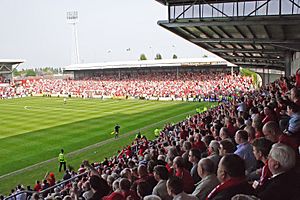
Wrexham has a professional football team, Wrexham A.F.C. It is the oldest football club in Wales. Their home ground is the Racecourse Ground, the oldest international football ground in the world.
The Football Association of Wales was based in Wrexham from its start in 1876 until 1991.
Colliers Park has been improved and is now a National Development Centre for football.
On November 16, 2020, actors Ryan Reynolds and Rob McElhenney took over the club.
Rugby League
In 2010, Wrexham became home to the Celtic Crusaders rugby league club. They played in the Super League for two seasons. After the club faced problems, a new club, North Wales Crusaders, was formed. In 2016, the club moved to the Queensway Stadium in Caia Park.
Rugby Union
The Racecourse Ground has also hosted Scarlets rugby union games. The Wales rugby union team has played there too. Wrexham is home to the Wrexham RFC rugby union team. In 1931, nine northern Welsh clubs met in Wrexham to form the North Wales Rugby Union.
Other Sports
- Athletics – Queensway International Athletics stadium is Wrexham's second stadium. It hosts the Welsh Open Athletics event. It is also home to Wrexham Amateur Athletics Club.
- Hockey – Plas Coch has the North Wales Regional Hockey Stadium. It is home to Wrexham Glyndwr HC.
- Leisure centres – Wrexham has 7 leisure centers, including Waterworld. They offer swimming, aerobics, climbing, and yoga.
- Tennis – Wrexham has the North Wales Regional Tennis Centre. It hosts international competitions.
- Golf – Wrexham has 4 golf courses: Moss Valley Golf Club, Plassey Golf Club, Wrexham Golf Club, and Clays Farm Golf Club.
Religion
Parish Church of St. Giles
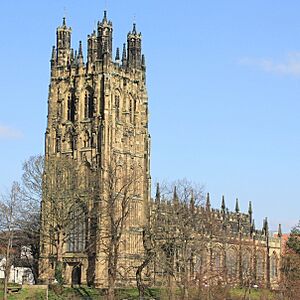
St. Giles is the main Anglican church in Wrexham. It is considered the greatest medieval church in Wales. It has a colorful ceiling with flying musical angels. In the graveyard is the tomb of Elihu Yale, who helped found Yale University in the United States. A smaller copy of the church tower, called Wrexham Tower, was built at Yale University. The tower is mentioned as one of the Seven Wonders of Wales. In 2015, a first edition (1611) of the King James Bible was found in the church.
St. Mary's Cathedral
The Roman Catholic Cathedral of Our Lady of Sorrows is on Regent Street. It is the main church for the Diocese of Wrexham, which covers all of North Wales. Built in 1857, it became the home of the Bishop of Wrexham in 1987. The cathedral also holds a relic of Saint Richard Gwyn, Wrexham's patron saint. He was a Catholic who was executed in the 16th century.
Other Churches
Wrexham has many other churches and chapels. These include a branch of The Salvation Army. The main Methodist church is Wrexham Methodist church, built in 1971. There is also a Presbyterian church.
Education
Wrexham University
Wrexham University became a full university in 2008. It has the Plas Coch campus and the North Wales School of Art and Design on Regent Street. The university started in 1887 as the Wrexham School of Science and Art. It was previously named after the 14th-century Welsh prince, Owain Glyndŵr.
Yale College (Coleg Cambria)
Yale College is now part of Coleg Cambria. It is a major provider of adult education in Wrexham. It also offers many higher education courses. It was named after Elihu Yale.
Yale College moved to two sites in Wrexham in 1998. In 2013, Yale College merged with other colleges to form Coleg Cambria. For the 2020–21 school year, the Yale Grove Park Campus in Wrexham city center was redeveloped. The new Hafod building, costing £20 million, is a "commercial village."
Schools
Wrexham has many primary and secondary schools. Ysgol Morgan Llwyd is the only Welsh-speaking secondary school. In 2003, three large secondary schools merged to create two bigger "super schools": Rhosnesni High School and Ysgol Clywedog. St Joseph's is the first shared-faith school in Wales.
There are seven Welsh-medium primary schools in Wrexham County Borough. Two are in Wrexham city: Ysgol Bodhyfryd CP and Ysgol Plas Coch CP. Ysgol Morgan Llwyd is the Welsh-medium secondary school for the county.
Twin Municipalities
Wrexham is twinned with the German district of Märkischer Kreis and the Polish town of Racibórz.
The first twinning began on March 17, 1970. In 2001, Märkischer Kreis also twinned with Racibórz in Poland. This led to Wrexham and Racibórz signing a twinning agreement in March 2004. Wrexham has strong historical ties with Poland. Many Polish service members who were injured in World War II were treated at Penley Polish Hospital. Their families still live in the area today.
Transport
Rail Travel
Wrexham has two railway stations: Wrexham General and Wrexham Central. Gwersyllt is in the city's western suburbs.
- Wrexham General
Wrexham General opened in 1846. It has six platforms. It is on two lines: the Shrewsbury to Chester Line and the Borderlands Line. Both are run by Transport for Wales.
A Avanti West Coast service runs from Wrexham General to London Euston via Chester and Crewe. Transport for Wales also runs direct services to Liverpool Lime Street.
- Wrexham Central
Wrexham Central is a small station on the Island Green retail park. It is the southern end of the Borderlands Line to Bidston in Birkenhead.
- Gwersyllt
Gwersyllt is an unmanned stop in the Gwersyllt suburb. It is on the Borderlands line between Wrexham General and Bidston.
Bus Services
Wrexham has a large bus terminal. It serves local, regional, and long-distance bus services. Companies like Arriva Buses Wales and Stagecoach operate here. Long-distance coaches go to Edinburgh and London. The Wrexham Shuttle connects the city to the industrial estate. The townlink bus connects the main bus station to shopping centers and train stations. Wrexham is also served by the National Express coach network. Wrexham uses distinctive yellow American Bluebird school buses.
Roads
A ring road goes around the city center. The A483 is Wrexham's main road. It runs along the western edge of the city. This road connects to major routes like the A55 and A5. The A5156 leads to the Wrexham Industrial Estate. The A541 road is the main route into Wrexham from Mold.
Future Development
The Welsh Government has bought key sites for the Wrexham Gateway Project. This project aims to redevelop the Kop stand at the Racecourse Ground. It also plans to upgrade the transportation network to support the sports and event facility.
Funding of £5.4 million was agreed for the redevelopment of the Wrexham Museum. This project integrates a Welsh Football Museum. The football museum will cover themes like Welsh language communities, fan culture, and diverse experiences.
A health and wellbeing complex at Coleg Cambria was completed by summer 2024. It cost £14 million.
Work began on the regeneration of the historic markets by the contractor SWG. This project aims to improve the Grade II-listed General and Butchers markets.
Funding for Wrexham University's Enterprise Engineering and Optics Centre (EEOC) was secured. Wynne Construction began work on the Plas Coch campus in 2024. This is part of a larger plan to improve facilities at Wrexham University Plas Coch campus.
A Ryan Rodney Reynolds memorial park was officially announced on October 23, 2023. It is expected to include play areas, tables, chairs, artworks, street food, and a community cinema.
Notable People

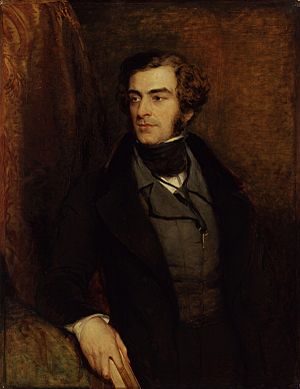
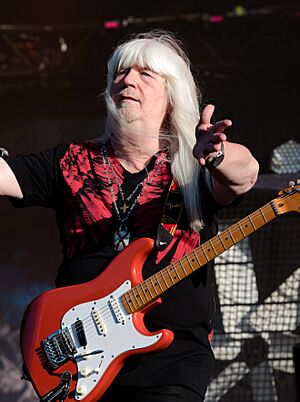
- Saint Richard Gwyn (1537–1584), Catholic saint and Patron Saint of Wrexham. He was executed in Wrexham for his beliefs.
- Elihu Yale (1649–1721), a businessman who helped fund Yale University.
- John "Iron-Mad" Wilkinson (1728–1808), known for Bersham Ironworks.
- Samuel Warren (1807–1877), a British lawyer, novelist, and MP.
- Edwin Hughes (1830–1927), known as Balaclava Ned, the last survivor of the Charge of the Light Brigade.
- Andy Scott (born 1949), guitarist with the 1970s glam rock band The Sweet.
- Tim Vincent (born 1972), a former Blue Peter presenter.
- Amy Guy (born 1983), a Welsh beauty queen and TV performer.
Sporting Figures
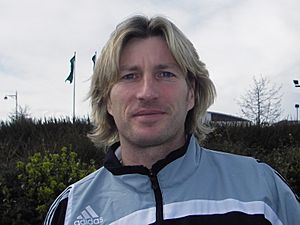
- James Trainer (1863–1915), a football goalkeeper for Wales.
- J. G. Parry-Thomas (1884–1927), a motor-racing driver and land speed record holder.
- Dennis Taylor (born 1949), a former snooker World Champion.
- Mark Hughes (born 1963), a former Wales international footballer and manager.
- Robbie Savage (born 1974), a former Wales international footballer.
- Chris Bartley (born 1984), a rower who won a silver medal at the 2012 Summer Olympics.
- Tom James (born 1984), an Olympic Gold Medallist rower.
- Laura Deas (born 1988), a skeleton ski racer who won a bronze medal at the 2018 Winter Olympics.
- Harry Wilson (born 1997), a footballer for Fulham and Wales.
Freedom of the City
The following people and military units have received the Freedom of the City of Wrexham.
Individuals
- Ryan Reynolds: April 10, 2023.
- Rob McElhenney: April 10, 2023.
Military Units
- Royal Welch Fusiliers: June 5, 1946.
- The Royal Welsh: 2008.
- 101 Force Support Battalion, Royal Electrical and Mechanical Engineers: April 5, 2013.
- The Welsh Guards: July 18, 2014.
See also
 In Spanish: Wrexham para niños
In Spanish: Wrexham para niños


